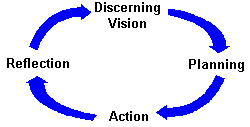
Prayer for Vision |
|
| Prayer is powerful.
Vision is energising. Combining the two enables the church to undergo a spiritual
pilgrimage into the future that God is calling. Yet, for many churches, even praying
churches with vision, the two are not combined. Consider the elements of prayer and vision. Firstly, vision. Without a clearly stated and well communicated vision, the church will stand still, enjoying the present, or even the past! A vision seeks to identify the corporate and specific vocation of the church. Corporate in that it is a community calling, and specific in that each church is called to focus on different things at different times. Second, strategic intercession. Strategic can mean a range of things - or nothing at all - it seems to be the latest buzz word to add in front of every act that we do to make us feel we are working on something important. In this context, I mean prayer that is informed by the thoughts and desires of the church, yet open to the Lord's prompting. Strategic intercession allows the church to pray corporately it's journey of faith whether or not people are in the same building at the same time. |
|
| Discerning and moving into vision is a cyclical process. (illustrated right) It needs both prayer and action at each stage. Whilst it is a process, many churches and organisations can be in all four phases at once as they pursue different (but hopefully complementary!) visions for different elements of the church's mission and ministry. |  |
| The first
phase requires two that the vision is developed in prayer, and supported by
prayer. Leaders cannot seek a vision for the future without themselves spending much
time in prayer, both individually and together as a team. Since we seek God's vision for
the church, encouraging members to pray for the vision process increases the number of
listening ears. (See our resources on vision forming.) Phase two creates the plans to achieve the vision - the projects, changes in organisation and activities that will be needed. The amount of action required increases as plans and strategies are drawn up, but this stage also requires careful prayer - the plans need to be the right ones! (See our resources on strategic planning.) The third phase sees the implementation of the changes and projects required to achieve the vision. Those who are action oriented can get on with the multiple tasks required, but the pray-ers also need to be fully involved. Prayer supports the implementation of change. Any vision requires change as the church moves into a different state. Any change brings challenge and conflict. Prayer can help this by minimising the conflict, and by directing pastoral care into the situations where it is needed. This phase of prayer may need to be carefully channelled to a specific group of trusted intercessors rather than to the general church community. (See our resources on introducing change, and handling conflict.) Finally, a period of
reflection enables a church to pray through the action it has just taken. Does it need
amending? Are there further steps required? This reflection is likely to develop into
seeking the next part of the vision and leads back into the first phase of the process.
This reflection should seek human views and feelings, but also through prayer, seek God's
viewpoint! |
|
| Pause for Thought : Take some time to reflect on the vision for your church or organisation. Which stage of the process do you think you are at? (It's possible to be at different stages of the process for different ministries within a church.) How can prayer best support the process of developing and moving into vision for your church or organisation? | |
